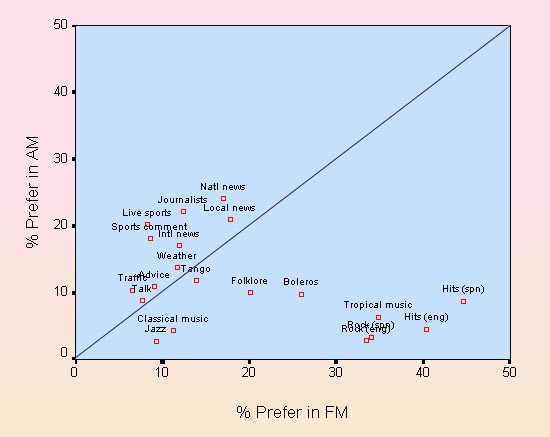
Buenos Aires, Argentina
(photo credit: R. Soong)
AM vs. FM Radio Preferences

Buenos Aires, Argentina
(photo credit: R. Soong)
Radio signals are electromagnetic waves that are sent from a transmitter to one or more receivers. All electromagnetic waves travel at the speed of light, but they can have different wavelengths and frequencies. Radio signals occupy certain ranges of the electromagnetic frequency spectrum.
First of all, there is the AM band of frequencies. These are electromagnetic waves with frequencies between 535 kHz and 1605 kHz (where a "kHz" represents a kilo Hertz, or 1000 oscillations per second). The AM (Amplitude Modulation) method involves the encoding of the original sound through modulating or changing the amplitude of the radio signal, which is then decoded by the receiver to recover the original sound.
Each AM channel is assigned a range of frequencies, typically about 10 kHz wide. The common frequency identification (such as AM 1190 for America AM 1190) represents the midpoint of this operating channel range. Actually, the station uses only about 2.5 kHz on either side of this midpoint because of the interference problems outside. Therefore, the total bandwidth of an AM channel is typically about 5 kHz. The musical range of the human ear is about 20 kHz, and that is the reason why AM sounds imperfect.
Theoretically, there can be at most (1605-535)/10 = 107 AM stations in an area. In practice, the number of AM stations in an area is much lower for a number of other reasons. AM signals can be reflected from the ionospheric layer back to earth, so that the signals can reach unintended places that are thousands of miles away. Further, the ionospheric reflection is increased during the night time. Therefore, the AM signal from a powerful station in one city can be received in another city, which may be in another country. For example, when Cuba was attempting to interfere with the broadcasts of Radio Martí in Florida, their signals were interfering with a radio station in Iowa. Consequently, AM signals are often subject to regulations such as the use of directional antennae or reduced power at night time or even going off the air at night.
Then there is the FM band of frequencies. These correspond to electromagnetic waves with frequencies between 88 mHz and 108 mHz (where a "mHz" represents a million Hertz, or 1,000,000 oscillations per second). With respect to television signals, the FM band occupies the spectrum between channels 6 and 7 on the VHF dial. The FM (Frequency Modulation) method involves the encoding of the original sound through modulating or changing the frequency of the radio signal, which is then decoded by the receiver to recover the original sound.
Each FM channel is assigned a bandwidth of 200 kHz, and the midpoint of this operating channel range is used for identification purposes (such as Station FM for FM 104.1). This means that there can be at most a maximum of (108-88)/0.2 = 100 stations on the FM dial. The FM bandwidth can easily cover the musical range of the human ear of about 20 kHz, and that is why FM radio sounds better than AM radio. In fact, the bandwidth allows FM to be broadcast in stereo.
At the higher frequencies, the FM signals pass unreflected through the ionosphere, during the day as well as at night. In other words, the FM signals operate by line of sight. Of course, this limits the coverage area of a FM channel. The size of the coverage area depends on the height of the transmission antenna, which is often located at the top of very tall buildings. At the fringe of the coverage area or when the signal is blocked by landmass or buildings, the FM signal may deteriorate in quality.
The above discourse on the physics of radio engineering serves to bring out these points:
There is a limit on the number of radio stations that can operate in an area
AM radio has wider coverage than FM radio
FM radio has better sound quality than AM radio
Here we will cite some survey data from the TGI Argentina study. This is a survey of 12,346 persons between 12 and 75 years old conducted by IBOPE Argentina during 1999-2000. These respondents were presented with a list of radio program types and ask their preferences for either AM or FM reception in listening to each program type. Each respondent may indicate an preference for AM or FM or indifference. The survey results are shown in the form of a scatterplot below.

(Source: TGI Argentina, IBOPE Argentina)
The scatterplot contains a 45 degree diagonal line. Any radio program type that is below this diagonal line is preferred more in FM, and any program program type above this diagonal line is preferred more in AM. Clearly, the consumers prefer to listen to music in FM and to spoken words in AM. There are two interpretations of this phenomenon. First of all, this reflects the strengths of each transmission method --- larger coverage with theoretically poorer quality for AM, and smaller coverage with theoretically better quality for FM. Alternately, this simply reflects the fact that AM stations carry mostly spoken words and FM stations carry most music, each playing to its own perceived strengths. Thus, the most and the best music programs are found on the FM spectrum, and the most and the best news programs are found on the AM spectrum.
![]()
WWW REFERENCES
PRINT REFERENCES
(posted by Roland Soong on 7/18/00)
(Return to Zona Latina's Home Page)